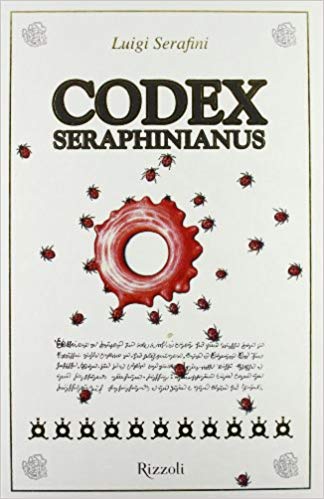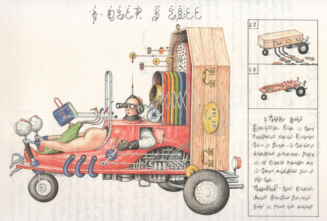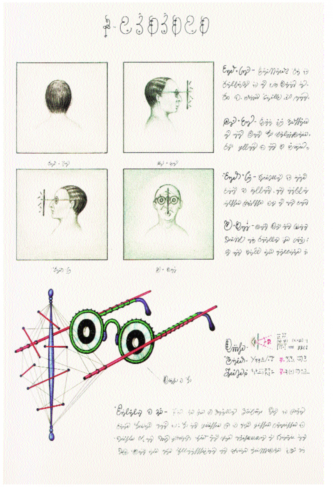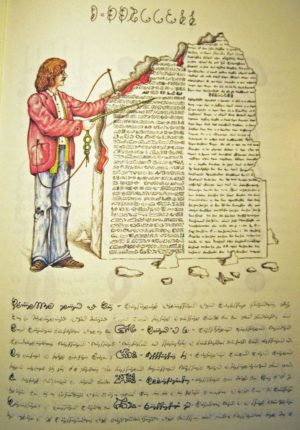 The strangest book in the world? That’s easy: it’s the mind-bending CODEX SERAPHINIANUS by Luigi Serafini.
The strangest book in the world? That’s easy: it’s the mind-bending CODEX SERAPHINIANUS by Luigi Serafini.
Quite simply, the CODEX is an astonishing piece of work whose conviction and imaginative fecundity are without precedent, being a guidebook to an alien planet that resembles our own in many bizarre ways. The only thing is, the whole thing is written in a completely made-up language—pages and pages of it, along with complex mathematical diagrams—accompanied by illustrations that often seem equally incomprehensible.
Yet the language and artwork have a way of complementing one another that’s downright ingenious. Even at its most baffling, the book possesses an inscrutable dream-logic that holds one’s attention. In the end, one can take CODEX as a serious (if whimsical and somewhat grotesque) science fictionish attempt at depicting an extraterrestrial landscape, or as an elaborate surrealist put-on. I personally believe it’s a little of both.
The very definition of a cult book, CODEX SERAPHINIANUS began life as a two-volume work published in Italy by Franco Maria Ricci in 1981. Its creator Luigi Serafini is an Italian architect who wrote and illustrated this surreal epic during the late seventies (and in 1984 published another book called PULCINELLOPEDIA PICCOLA). The book, which has since been compressed into a single volume, quickly amassed a limited but enthusiastic following. I myself only learned of its existence in mid 2007, but immediately joined the ranks of CODEX buffs.
I said this book is without precedent, but it dimly recalls Jorge Luis Borges’ immortal tale “Tlon, Uqbar, Orbus Tertius”, which  explores the bizarre philosophies and beliefs of people living on an invented world. More minor similarities can be found in the Harlan Ellison edited MEDEA: HARLAN’S WORLD (1985), in which several top sci fi writers analyze the particulars of an alien society, and the 1973 French animated film FANTASTIC PLANET (LA PLANETE SAUVAGE), whose hallucinogenic Roland Topor-designed images will resonate with CODEX fans.
explores the bizarre philosophies and beliefs of people living on an invented world. More minor similarities can be found in the Harlan Ellison edited MEDEA: HARLAN’S WORLD (1985), in which several top sci fi writers analyze the particulars of an alien society, and the 1973 French animated film FANTASTIC PLANET (LA PLANETE SAUVAGE), whose hallucinogenic Roland Topor-designed images will resonate with CODEX fans.
There’s also THE VOYNICH MANUSCRIPT, an apparently medieval text written in a language nobody has yet been able to decipher, that like CODEX appears to be a sort of scientific guidebook. The difference between the two is that unless you’re a medieval scholar THE VOYNICH MS, based on what I’ve seen of it, isn’t terribly interesting, whereas CODEX SERAPHINIANUS very much is. If nothing else, Luigi Serafini’s eerily beautiful images are a constant wonder to behold, vaguely echoing Hieronymus Bosh and M.C. Escher, and perpetually challenging the spectator to decipher them.
 Many commentators claim to have discovered a way to translate Serafini’s language and numerology system, but I believe that takes away one of the book’s primary pleasures. In CODEX SERAPHINIANUS the cognitive process is forced into play in a manner that’s virtually unique, providing one with hours of fascination. If you’re willing to grant it your full attention, I guarantee CODEX will suck you in.
Many commentators claim to have discovered a way to translate Serafini’s language and numerology system, but I believe that takes away one of the book’s primary pleasures. In CODEX SERAPHINIANUS the cognitive process is forced into play in a manner that’s virtually unique, providing one with hours of fascination. If you’re willing to grant it your full attention, I guarantee CODEX will suck you in.
CODEX SERAPHINANIUS begins with a (newly written)prologue, followed by eleven self-contained sections, each exploring an aspect of the strange world under review: plant and animal life, the languages spoken by its human(oid) inhabitants, the clothing they wear, their vehicles, living quarters, grooming and eating preferences, etc.
Despite the guidebook format, certain portions appear to tell a (symbolic?) story, such as the sequence of illustrations depicting a lovemaking couple who metamorphose into an alligator, or the roller skate wearing man who’s seen on one page writing with a quill pen he has in place of a right hand, and impaled by a giant pencil on the next.
Much of the book seems comprehensible enough, yet Serafini often adds one or more seemingly inconsequential details that subtly throw things off. In one more-or-less straightforward illustration a reverential crowd flanks a red carpet, along which struts a tiny creature with two legs topped by what looks like a seashell—but the strangest part is that among the crowd is a dead man standing upright in an open coffin! Also, a picture that occurs near the end depicts a condominium that stretches into the clouds…and alongside it an indistinct person falling to his/her death.
Other puzzlements: a pair of eyeglasses with a maze-like contraption in front of them that would appear to seriously obstruct their wearer’s vision; a rainbow-making machine seen zooming across the sky, alongside which are pictures of discarded rainbows twisted into spirals, tied in knots, etc.; a gallery of eye diagrams, one of which shows a cracked eyeball with music notes emanating from it; a headless, suspender-wearing torso that bursts open to disgorge a ravenous leopard.
Equally perplexing are the many symbols and motifs of our world that turn up in this one, often in wildly unexpected permutations. Arrows, streetlights and fried eggs(!) are constants, as are bones, masks and flags—but I’ll leave it to you to discover, and ponder,  these things on your own.
these things on your own.
Obviously any attempt at fully understanding this nutty universe is doomed to failure. This is enumerated in the book’s most remarked-upon image, of a crumbling Rosetta Stone utilized by a professorial dude translating some unknown language for us…into the nonsensical dialect of the rest of the book.
As for obtaining a copy of the CODEX for yourself, I’ve got good news: after decades of obscurity, during which interested parties were at the mercy of greedy used booksellers (who tended to charge in excess of $100), the CODEX and its follow-up PULCINELLOPEDIA PICCOLA (since retitled PULCINELLOPEDIA SERAPHINIANA) are back in print, courtesy of Rizzoli. Neither book is cheap, but I can assure you that it will be well worth your while investing in CODEX SERAPHINIANUS, unquestionably the strangest book in the world.
